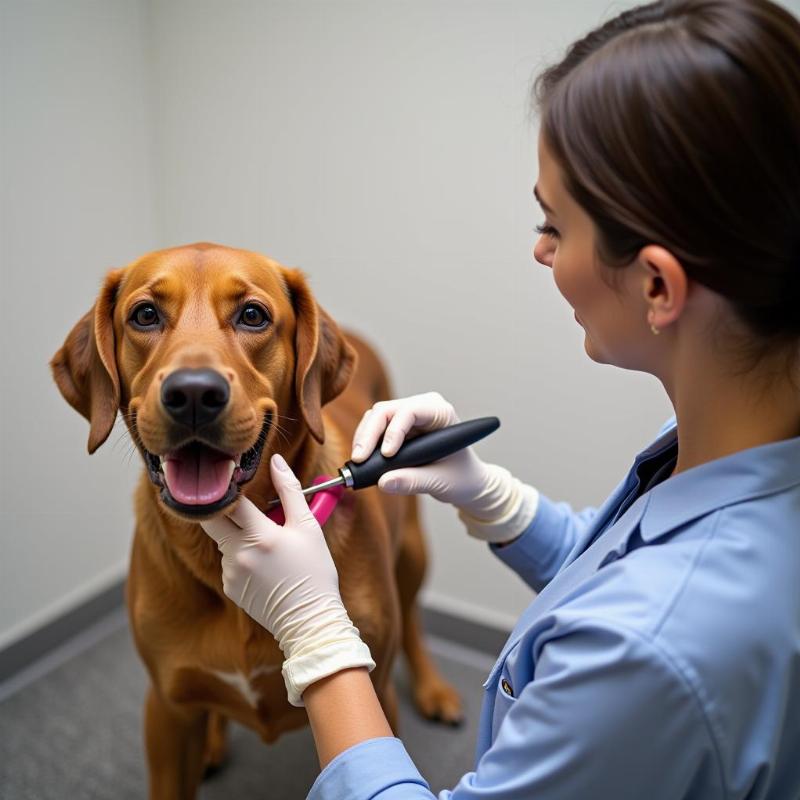Antibiotic spray for dog skin infections can be a helpful tool in treating bacterial skin issues in your furry friend. However, choosing the right spray and using it correctly is crucial for effective treatment and to prevent antibiotic resistance. This guide will walk you through everything you need to know about using antibiotic sprays for dog skin infections, from understanding the causes and symptoms to choosing the best product and administering it safely.
Understanding Dog Skin Infections
Skin infections in dogs are common and can be caused by various factors, including bacteria, fungi, parasites, and allergies. Bacterial infections, often characterized by redness, swelling, pus, and itching, are frequently treated with topical antibiotic sprays. It’s important to remember that not all skin issues require antibiotics, so a proper diagnosis from a veterinarian is essential before starting any treatment.
Choosing the Right Antibiotic Spray
Numerous antibiotic sprays are available for dogs in the US market, each with its active ingredients and intended use. Some common active ingredients include gentamicin, mupirocin, and bacitracin. Your veterinarian can recommend the most suitable spray for your dog’s specific infection and overall health. Factors such as the severity of the infection, the location on the body, and your dog’s age and breed will influence their recommendation. Never use human antibiotic sprays on your dog, as they can be harmful.
Applying Antibiotic Spray Correctly
Before applying the spray, gently clean the affected area with a mild antiseptic solution recommended by your vet. This will remove debris and allow the medication to penetrate the skin effectively. Hold the spray bottle a few inches away from your dog’s skin and apply a thin, even layer as directed by your veterinarian or the product label. Avoid spraying near your dog’s eyes, nose, and mouth. Prevent your dog from licking the treated area for at least 10-15 minutes to ensure proper absorption.
Preventing Further Infections
While antibiotic spray treats the existing infection, it’s crucial to address underlying causes to prevent recurrence. Allergies, parasites, and poor hygiene can contribute to skin infections. Work with your vet to identify and address these issues. Regular grooming, a balanced diet, and a clean environment can significantly reduce the risk of future skin problems. treating clipper burn on dogs can be important to prevent secondary infections.
When to See a Veterinarian
While antibiotic sprays can be effective, some skin infections require more intensive treatment. If your dog’s condition doesn’t improve within a few days of using the spray, or if the infection worsens, consult your veterinarian immediately. They may prescribe oral antibiotics, antifungal medications, or other treatments depending on the underlying cause.
 Veterinarian examining dog's skin
Veterinarian examining dog's skin
Conclusion
Antibiotic spray for dog skin infection is a valuable tool when used correctly and under veterinary guidance. By understanding the causes of skin infections, choosing the appropriate product, and following proper application techniques, you can help your furry friend recover quickly and comfortably. Remember, a visit to the veterinarian is the first step in ensuring your dog receives the best possible care. Don’t hesitate to reach out to your vet if you have any concerns about your dog’s skin health. gentaved topical spray for dogs might be a suitable option, but always consult your veterinarian.
FAQ
- Can I use human antibiotic spray on my dog? No, human antibiotic sprays are formulated differently and can be harmful to dogs. Always use a veterinary-approved product.
- How long does it take for antibiotic spray to work on a dog? Improvement is typically seen within a few days, but complete healing can take several weeks.
- What should I do if my dog licks the sprayed area? Try to distract your dog and prevent licking for at least 10-15 minutes after application.
- Can antibiotic spray be used for all types of dog skin infections? No, it is primarily effective against bacterial infections. Fungal or parasitic infections require different treatments. hot spot wipes for dogs might be more appropriate for certain skin issues.
- Are there any side effects of using antibiotic spray on dogs? Some dogs may experience mild skin irritation or redness at the application site. If you notice any adverse reactions, contact your veterinarian. gentacalm spray for dogs uses can be found online but consult your vet first.
- How can I prevent my dog from getting skin infections? Regular grooming, a healthy diet, parasite prevention, and a clean environment can significantly reduce the risk of skin infections. shampoo for dogs with hot spots can be part of a preventative care routine.
- My dog has a recurring skin infection. What should I do? Consult your veterinarian to determine the underlying cause and discuss long-term management strategies.
Beautdogs.us is your trusted source for comprehensive and engaging information on dog care, breeds, and products. We cater to both novice and experienced dog owners, providing expert advice and valuable resources. Our mission is to empower you to provide the best possible care for your beloved canine companion. For personalized support and product recommendations, contact us at [email protected] or call us at +1 501-555-7529. Beautdogs.us is your one-stop shop for all your dog’s needs.